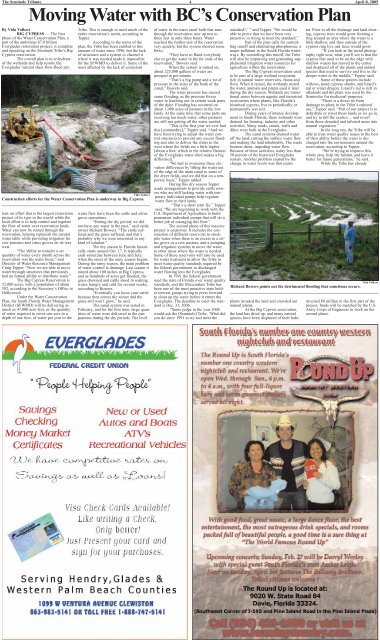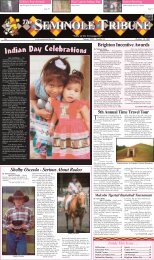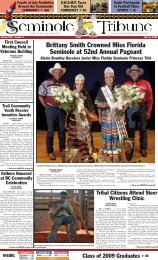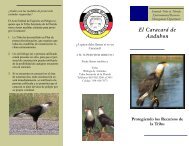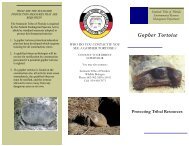You also want an ePaper? Increase the reach of your titles
YUMPU automatically turns print PDFs into web optimized ePapers that Google loves.
The <strong>Seminole</strong> Tribune 4 <strong>April</strong> 8, 2005Moving Water with BC’s Conservation PlanBy Vida VolkertBIG CYPRESS — The firstphase <strong>of</strong> the Water Conservation Plan, apart <strong>of</strong> the ambitious $7.8 billionEverglades restoration project, is completeand operating on the <strong>Seminole</strong> <strong>Tribe</strong>’s BigCypress reservation.The overall plan is to re-hydrate<strong>of</strong> the wetlands and help restore theEverglades’ natural sheet flow-flood pattern–aneffort that is the largest restorationproject <strong>of</strong> its type in the world–while thelocal effort is to help control and regulatethe flow <strong>of</strong> water over reservation lands.Water can now be routed through thereservation, helping replenish the naturalwater table while providing irrigation forcow pastures and citrus groves on its waywest.“The ability to transfer a setquantity <strong>of</strong> water every month across thereservation was the main focus,” saidDirector <strong>of</strong> Water Resource ManagementCraig Tepper. “Now we are able to movewater through structures that previouslyhad no formal ability to distribute water.”The Big Cypress Reservation is52,000 acres, with a population <strong>of</strong> about592, according to the Secretary’s Office inHollywood.Under the Water ConservationPlan, the South <strong>Florida</strong> Water ManagementDistrict (SFWMD) will be delivering asmuch as 47,000 acre-feet, or the quantity<strong>of</strong> water required to cover one acre to adepth <strong>of</strong> one foot, <strong>of</strong> water per year to the<strong>Tribe</strong>. This is enough to meet much <strong>of</strong> theentire reservation’s needs, according toTepper.According to the terms <strong>of</strong> theplan, the <strong>Tribe</strong> has been entitled to thisamount <strong>of</strong> water since 1996, but the lack<strong>of</strong> structures and a system to channel itwhere it was needed made it impossiblefor the SFWMD to deliver it. Some <strong>of</strong> themost affected by the lack <strong>of</strong> consistentVida VolkertConstruction efforts for the Water Conservation Plan is underway in Big Cypress.water flow have been the cattle and citrusgrove operations.“During the dry period, we didnot have any water in the past,” said cattleowner Richard Bowers. “The cattle sufferedand the grass suffered, and that’sprobably why we were interested in anykind <strong>of</strong> solution.”The dry season in <strong>Florida</strong> historicallystarts around Oct. 17. It typicallyends sometime between June and July,when the onset <strong>of</strong> the rainy season begins.During the rainy season, the main problem<strong>of</strong> water control is drainage. Last season itrained about 100 inches at Big Cypress,and as hundreds <strong>of</strong> acres got flooded, thegrass drowned and cattle stood in soakingwater, hungry and cold for several weeks,according to Bowers.“Eventually you loose your cattlebecause then comes the winter and thegrass still won’t grow,” he said.The canal system was tested inFebruary, and for the first time, large quantities<strong>of</strong> water were delivered to the cawpastures during the dry periods. The level<strong>of</strong> water in the main canal built that runsthrough the reservation rose up two tothree feet in only three hours. Waterreached the further end <strong>of</strong> the reservationvery quickly, but the system showed someflaws.“They have to flood everybodyelse to get the water to the far ends <strong>of</strong> thereservation,” Bowers said.When the system is turned on,about 225,000 gallons <strong>of</strong> water arepumped in per minute.“That’s a big pump and a lot <strong>of</strong>pressure in the sides <strong>of</strong> the bank <strong>of</strong> thecanal,” Bowers said.The water pressure has causedsome flooding, as the pressure forceswater to leaching out in certain weak parts<strong>of</strong> the dyke. Flooding has occurred onabout 1,000 acres <strong>of</strong> pastures in the lowlands. At the same time that some parts arereceiving too much water, other pasturesare still not getting all the water needed.“This is the first year we ever hadthis [commodity],” Tepper said. “And wehave been trying to adjust the water controlstructures to prevent any excess floodingand also to deliver the water to thewest where the fields are a little higher[about a foot, which in the relative flatness<strong>of</strong> the Everglades water-shed makes a bigdifference].”“We had to overcome these elevationdifferences by lifting the water out<strong>of</strong> the edge <strong>of</strong> the main canal to some <strong>of</strong>the dryer fields, and we did that on a temporarybasis,” Tepper added.During this dry season Teppermade arrangements to provide cattle ownerswho are still lacking water with temporaryindividual pumps help regulatewater flow to their lands.“That’s a short term fix,” Teppersaid. “We are beginning to work with theU.S. Department <strong>of</strong> Agriculture to buildpermanent individual pumps that will do abetter job <strong>of</strong> managing this flow.”The second phase <strong>of</strong> this massiveproject is underway. It includes the construction<strong>of</strong> different reservoirs to stockpilewater when there is an excess in a citrusgrove or a cow pasture, and a pumpingand irrigation systems to move the waterto other areas where the water is needed.Some <strong>of</strong> these reservoirs will also be usedfor water treatment to allow the <strong>Tribe</strong> tomeet water quality standards required bythe federal government to dischargedwater flowing into the Everglades.In 1991 the federal governmentsued the state <strong>of</strong> <strong>Florida</strong> over water qualitystandards, and the Miccosukee <strong>Tribe</strong> hasbeen one <strong>of</strong> the most proactive state holderinterest groups trying to press forwardto clean up the water before it enters theEverglades. The deadline to meet the standardis Dec. 31, 2006.“Some judge in the year 2006would ask the [<strong>Seminole</strong>] <strong>Tribe</strong>, ‘What didyou do since 1991 to try and meet thestandard?,’ ” said Tepper. “We would beable to prove that we have been veryproactive in trying to meet the standard.”Part <strong>of</strong> the plan calls for controllingrun<strong>of</strong>f and eliminating phosphorous, amajor pollutant in the South <strong>Florida</strong> waterways.By controlling this run<strong>of</strong>f, the <strong>Tribe</strong>will also be improving and generating supplementalirrigation water resources foragriculture within the reservation.The Big Cypress reservation usedto be part <strong>of</strong> a large wetland ecosystem,rich in natural water reservoirs, fauna andflora. When it rained, the wetlands storedthe water, animals and plants used it laterduring the dry season. Wetlands are transitionalzones between aquatic and terrestrialecosystems where plants, like <strong>Florida</strong>’shistorical cypress, live in periodically orpermanently wet soil.During years <strong>of</strong> intense developmentin South <strong>Florida</strong>, these wetlands weredrained for farming, industry and otheractivities. Many roads, canals, walls anddikes were built in the Everglades.The canal systems drained water<strong>of</strong>f the land, cutting the surface water flowand making the land inhabitable. The roadsbecame dams, impeding water flow.Because <strong>of</strong> these activities, today less than50 percent <strong>of</strong> the historical Evergladesremain. Another problem caused by thechange in water levels was that exoticplants invaded the land and crowded outnatural plants.At the Big Cypress reservation,the land has dried up, and many naturalspecies have been displaced <strong>of</strong> their habitat.Prior to all the drainage and land clearing,cypress trees would grow forming aring around an area where the water is alittle shallow, and then outside <strong>of</strong> thecypress ring live oak trees would grow.“If you look at the aerial photographyright now, what you’ll see is that thecypress that used to be on the edge withshallow waters has moved to the centerand displaced all <strong>of</strong> the plants and animalspecies that used to survive and live in thedeeper water in the middle,” Tepper said.Some <strong>of</strong> those species includewillows, pond cypress shrubs, and lizard’stail or water dragon. Lizard’s tail is rich inalkaloids and the plant was used by the<strong>Seminole</strong>s for medicinal purposes.“There is a direct tie fromdrainage to plant, to the <strong>Tribe</strong>’s culturaluse,” Tepper said. “Part <strong>of</strong> our project is todehydrate or rewet those lands as we go in,and try to kill the exotics… and revertfrom these denuded and infested areas intonatural vegetation.”In the long run, the <strong>Tribe</strong> will beable to treat water quality issues to the best<strong>of</strong> their ability before the water is dischargedinto the environment around thereservation, according to Tepper.“We’re trying to improve thiswhole area, help the habitat, and leave itbetter for future generations,” he said.While the <strong>Tribe</strong> has alreadyRichard Bowers points out the detrimental flooding that sometimes occurs.Vida Volkertinvested $8 million in the first part <strong>of</strong> theproject, funds will be matched by the U.S.Army Corps <strong>of</strong> Engineers to work on thesecond phase.


